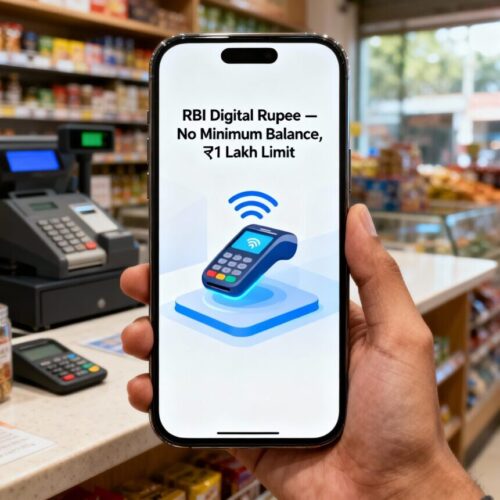RBI Sets Digital Rupee Wallet Rules: No Minimum Balance, ₹1 Lakh Limit
The Reserve Bank of India (RBI) has outlined a clear operational structure for users of its newly launched Offline Digital Rupee (e₹) wallets. The central bank confirmed that wallets will carry no minimum balance requirement, while daily transactions are capped at ₹50,000 or 20 transfers, and wallet balances cannot exceed ₹1 lakh.
Key Features and Limits
According to the RBI Digital Rupee framework, customers using official e₹ wallets — issued through the 15 participating banks — can conduct peer-to-peer (P2P) and person-to-merchant (P2M) transactions seamlessly, both online and offline. These wallets act as secure digital purses, mirroring the convenience of physical cash but in a trusted, traceable digital format.
The core limits set by the RBI are as follows:
- No Minimum Balance Requirement: Users can maintain an empty balance without incurring any penalty or additional charge.
- Maximum Wallet Balance: ₹1,00,000 at any given time.
- Daily Transaction Limit: ₹50,000 or 20 transfers per day.
- Cooling Period for New Users: Newly registered users can initially carry out up to ₹5,000 in transactions per day for the first five days as a security safeguard.
Once this cooling period ends, users can access the full ₹50,000 transaction limit per day without restrictions.
Why These Limits Matter
The limits have been introduced to maintain an optimal balance between user convenience, risk control, and regulatory security. Since the Offline Digital Rupee allows transactions even without internet connectivity, RBI has intentionally implemented transaction ceilings to prevent misuse or double-spending risks.
Experts note that the system’s offline nature — using Near Field Communication (NFC) tap payments and telecom-assisted technology — makes it vital to limit fund exposure in case of device loss or unauthorized transfers. These safeguards are consistent with standard RBI practices for prepaid instruments and ensure consumer protection in a decentralized context.

Also Read:- Simple Energy’s New E-Scooter Patent: Ather Rizta Rival?
Wallet Accessibility and Participants
RBI’s Offline Digital Rupee wallets are now available through SBI, ICICI Bank, HDFC Bank, Union Bank of India, and other partner institutions. Customers can download the official wallets via the Google Play Store or Apple App Store, link them to their bank accounts, and begin using digital cash for transactions instantly.
Users can transact even in low-connectivity areas, a critical step toward advancing financial inclusion in rural India. The RBI’s “cash-like” model ensures that even small merchants or citizens without continuous internet access can perform secure digital payments.
How the Offline Mode Works
The Offline Digital Rupee allows payments in two ways:
- NFC Tap Payments: Devices simply tap to exchange digital currency securely, without requiring active connectivity.
- Minimal Signal Transfers: In areas with weak telecom coverage, small-value transactions can occur using low-data channels.
Transactions are processed instantly and irreversibly, functioning like cash transfers while retaining the advantages of traceability and digital accountability.
Consumer Safety and Privacy- RBI
The RBI has prioritized safety across devices. Wallets include PIN, biometric verification, and recoverability features in the event of device loss. For offline transactions, identity authentication is subject to multi-layer encryption protocols. The Digital Personal Data Protection Act, 2023 (DPDPA) ensures that no sensitive financial data is shared without user consent.
To further prevent fraud, the RBI’s regulatory circular enforces Anti-Money Laundering (AML) and Know Your Customer (KYC) checks for wallet holders, adapted from traditional bank onboarding procedures.

Also Read – JAIMEX 2025 | India-Japan Naval Exercise Enhances Indo-Pacific Cooperation
Economic Implications
The Offline Digital Rupee marks a new phase in India’s payment revolution, combining the safety of RBI-backed currency with the convenience of digital automation. The no-minimum-balance rule is particularly game-changing for individuals at the bottom of the financial pyramid, making digital uptake frictionless.
The ₹1 lakh cap ensures that wallets remain a medium for daily transactions, not speculation or large-value transfers. As RBI Governor Sanjay Malhotra highlighted during the Global Fintech Fest 2025, “The digital rupee is the closest equivalent to physical cash — secure, accountable, and accessible anytime, anywhere.”
This rollout reaffirms India’s leadership in Central Bank Digital Currency (CBDC) innovation. The move complements the country’s growing UPI ecosystem but also provides resilience against internet outages and cyber vulnerabilities.
Conclusion
The RBI’s approach — no minimum balances, a ₹1 lakh cap, and sensible transaction limits — reflects its measured vision for secure and scalable digital currency adoption. It balances innovation and regulation while prioritizing financial access, digital trust, and monetary stability.
By combining cutting-edge offline technology with traditional banking safeguards, the Reserve Bank has ensured that every Indian — connected or not — can access digital financial services safely, affordably, and instantly.
For more such updates and latest news on cars and bikes stay connected to times.motormitra.in
Thank you ..

